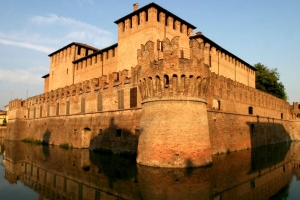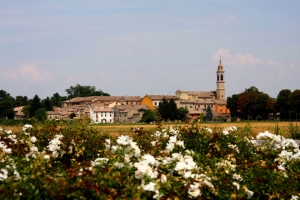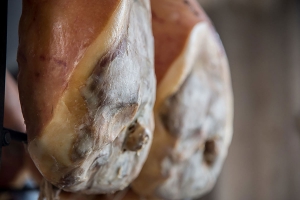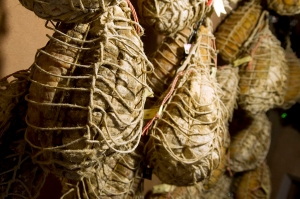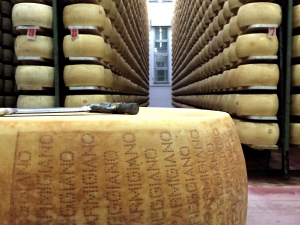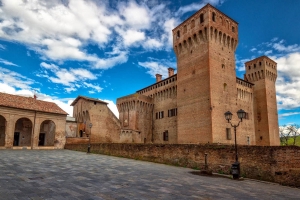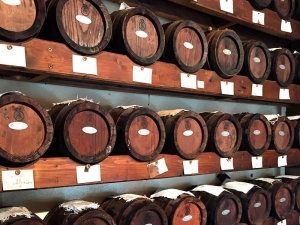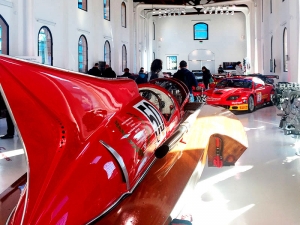Itinera Emilia
The Sanvitale Castle of Fontanellato
Famous for its beautiful moat, the castle that belonged to the Sanvitale houses two jewels: the “Optical Chamber” located in a tower and, on the ground floor, the small room decorated with frescoes of Parmigianino representing scenes from the life of Diana and Actaeon, taken from Ovid’s Metamorphoses. The quintessential 16th-century painting, the remarkable artistic quality of these works and the complexity of their interpretation never ceases to enchant visitors and academics.
To complete the tour, we cannot miss a stroll through the characteristic alleys of the village or having visited the Sanctuary of the Blessed Virgin of the Rosary which dates back to the 17th century and whose 1615 wooden statue of the Virgin has been the subject of great devotion and pilgrimages for more than four centuries.
The “Bassa”: Castles and delicacies
A visit suitable for groups and families that offers a glimpse of the quiet and placid landscape of the "Bassa", the area near the river Po, which is distinguished by the presence of beautiful castles and characteristic villages. Winter fog and summer heat are fundamental ingredients for some typical local products such as Culatello di Zibello and Spalla Cruda di Palasone and are part of the charm of this territory that has inspired musicians such as Giuseppe Verdi and writers such as Giovanni Guareschi.
A tour in close contact with nature, thanks to the presence of the main embankment that runs along the river bed and that is passable for long stretches.
Among the places not to be missed, included in our itineraries, are the Rocca di Fontanellato, the Rocca di Soragna, the Castle of Roccabianca, the Castle of San Secondo and the Labyrinth of Masone.
Parma Ham P.D.O.
The “Prosciutto di Parma” (from the Latin perexsuctum, literally “dry”) is a tasty and authentic product whose origins date back to antiquity. It is produced only with pork and salt. It owes its characteristics to the skill of the salt Masters and the dry and delicate air of the fragrant hills around Parma. A tour of a "prosciuttificio" (ham facility) lets you see the salting, drying and refining of the ham and to discover its secrets.
Absolutely recommended the tasting: prosciutto, homemade bread and a glass of Malvasia!
Culatello di Zibello P.D.O.
Always regarded as the most valuable and tasty deli of Parmesan tradition, Culatello di Zibello appears in the Slow Food catalogue of Emilia-Romagna and is defined as the king of deli meats. Made from the thigh of a pig introduced into a bladder, it is only worked in 9 villages of the “Bassa Parmense” area and refined for at least 10 months in the humid cellars close to the banks of the Po River.
Tasting is mandatory!
Wine cellars in Parma
The grape varieties of the Parma hills that accompany the dishes of traditional cuisine to perfection are the aromatic Malvasia di Candia, the Barbera, the Bonarda and, of course, the Lambrusco. Young and sparkling wines, combining lightness and cheerfulness. The tour of a wine cellar on the southern hills of the city lets them be tasted in association with typical local products, first of all the famous PDO (Parmigiano Reggiano, Prosciutto di Parma and Culatello di Zibello) that exalt their qualities.
Visit a Parmigiano Reggiano cheese factory
Produced exclusively with fresh milk with no preservatives, it is the fruit of a thousand-year tradition. A tour of a cheese factory will let you discover Parmigiano Reggiano P.D.O., the creation, salting and spectacular refining of the wheels.
You cannot miss the final tasting. Our guides are A.P.R. ( Parmigiano Reggiano Certified Taster), thanks to their indications you will be able to appreciate the characteristics of the different maturing times and the use of the King of cheeses in cooking.
The Fortress of Vignola (Modena)
Standing on its outcrop of the first hills of Modena, overlooking the Panaro Valley, the “Rocca” is among the most interesting examples of fortified architecture in Emilia. Standing on its dominant outcrop of the first hills of Modena, the Panaro Valley, the “Rocca” is among the most interesting examples of fortified architecture in Emilia. Although it was mentioned in documents from the 12th century, it was under the domination of the Este family and the investiture of Uguccione Contrari that the castle became a refined manor house.
Its imposing mass is softened inside thanks to the frescoes among which are those of the Chapel of Uguccione, an international Gothic jewel defined by the historian Carlo Arturo Quintavalle as “one of the most vivid and intense experiences among the Emilian works of the period” (A.C. Quintavalle, I freschi di Vignola e la pittura emiliana del primo Quattrocento, in "Arte Antica e Moderna", 1962).
Modena vinegar factory: the "acetaia"
The Consortium of Traditional Balsamic Vinegar in Modena guarantees the quality and the use of the traditional method for the production of this magical condiment, which is a real panacea for the palate and the spirit.
Traditional balsamic vinegar comes only from cooked grape must which, year after year, is aged slowly in wooden barrels with decanting that give the product unique flavors: tasting the different degrees of ripeness is an experience for true gourmets.
The Motorvalley
Ferrari, Lamborghini, De Tomaso : these names make the hearts of millions of people passionate about speed beat, fascinated by cars that have always been a real status symbol ... a mirage, for more, but since dreaming is a right, why not take a day to discover the territories where excellent mechanics originate? Itinera Emilia invites you to Modena, the capital of engines and a land where the thrill of speed and the charm of custom-built cars come together in a passion that has remained unchanged over time.
An itinerary can only begin near the historic center, in Largo Garibaldi, where there is the monument dedicated to Enzo Ferrari, founder of the mythical house of the prancing horse. Not far away, Viale Trento e Trieste hosted the first Ferrari workshop in the 1930s. In the city there are also two important private museums, the Stanguellini Historical Car Museum and above all the Car and vintage motorcycles Museum Umberto Panini , which presents one of the most complete collections of Maserati, a brand now controlled by Ferrari.
However, the place that most evokes the legend is Maranello, a center of production of extraordinary cars, and an obligatory arrival point of this route.
At the gates of the town is the Private Ferrari Track, test site for racing cars that will then whiz on the roads all over the world then you will meet the actual factory and finally the Galleria Ferrari , the goal of this pilgrimage dedicated to the myth-machine. In a crescendo of suggestions, thanks to models, trophies, films, the most exciting victories are relived, the most loved champions are remembered, one lets oneself go to the desire to fulfill a dream: to get behind the wheel of a "red". An innovative structure then completes the visit: the Wind tunnel , created by architect Renzo Piano in order to study aerodynamics.
And not far from Modena, in Sant’Agata Bolognese in the province of Bologna, it is possible to realize another dream: to see the birth of a Lamborghini! At the company you can visit the museum with historical models and be accompanied inside to see the assembly of a Gallardo or a Murcielago ...
This itinerary therefore intends to arouse enthusiasm, pay homage to a vibrant passion and, why not, leave an indelible trace imprinted in the memory of those who participate.
Classic Modena
The classic itinerary winds through the old town, touching the Ducal Palace which belonged to the Este, the area of the ancient Jewish Ghetto and the Synagogue, the Piazza Grande with the Town Hall and the Theater named after the great tenor Luciano Pavarotti.
The marvelous Cathedral of San Gimignano, considered a masterpiece of the Romanesque style, is a "book of stone" that, with an extraordinary sculptural decoration that extends over the façade, portals, capitals and metopse, has been telling the fantastic imaginary of the Middle Ages for over a thousand years; adjacent is the Ghirlandina tower . Both monuments are evidences of medieval history and, due to their inestimable value, belong to the UNESCO World Heritage Site.
